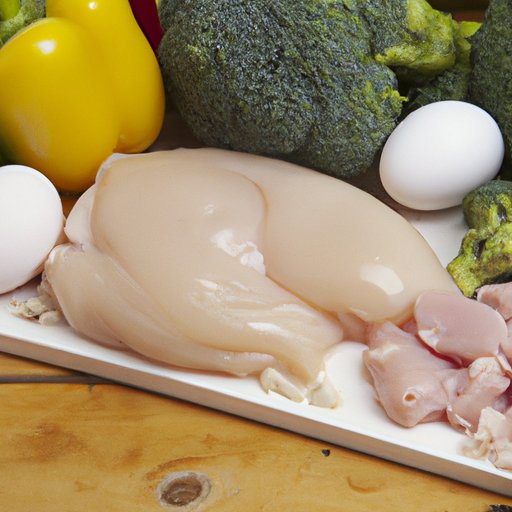Introduction
Protein is an essential macronutrient that plays a key role in many of the body’s processes. It is made up of amino acids that help build muscle, repair tissue damage, and balance hormones. Unfortunately, many people don’t get enough protein in their diets. Fortunately, there are plenty of ways to increase your intake through plant-based foods, such as vegetables.
Eating more vegetables rich in protein can be beneficial for overall health, as they provide essential vitamins and minerals in addition to protein. Additionally, they tend to be low in calories and fat, making them a great choice for weight loss or maintenance. In this article, we’ll explore the protein content of different vegetables and discuss how to select and prepare them for maximum benefit.

Comparing the Protein Content of Different Vegetables
When it comes to protein content, not all vegetables are created equal. Some are far higher in protein than others, while some contain no protein at all. Let’s take a look at the average amount of protein found in various types of vegetables.
Root vegetables such as potatoes, carrots, and beets are generally quite low in protein, with one small potato containing just 2 grams. Leafy greens like spinach and kale, on the other hand, have a much higher protein content, with one cup of cooked spinach providing 5 grams. Cruciferous vegetables like broccoli and cauliflower also have a decent amount of protein, with one cup of cooked broccoli providing 4 grams.
Legumes are another great source of vegetable protein. One cup of cooked lentils contains 18 grams of protein, while one cup of cooked black beans provides 15 grams. Peas and edamame are also high in protein, with one cup of cooked peas providing 8 grams and one cup of cooked edamame providing 11 grams.
Finally, mushrooms are a good source of vegetable protein, with one cup of cooked shiitake mushrooms providing 3 grams. Other types of mushrooms, such as portobello and maitake, contain slightly less protein, but are still a decent source.
A Guide to Picking Protein-Packed Produce
Now that you know which vegetables are highest in protein, here are some tips for selecting and preparing them for maximum benefit.
When shopping for produce, look for fresh, brightly colored vegetables that are free from blemishes or bruises. Avoid wilted or limp veggies, as these may be past their prime. Also, make sure to read labels carefully and choose organic, non-GMO varieties whenever possible.
When it comes to preparation, steaming or sautéing veggies is usually the best way to retain their nutritional value. Avoid boiling them, as this can leach out valuable nutrients. If you’re looking for a quick and easy meal, try roasting vegetables in the oven with a drizzle of olive oil and some herbs and spices.

The Best Sources of Vegetable Protein
Now that you know how to pick and prepare protein-rich vegetables, let’s take a closer look at the nutrient density of some of the best sources of vegetable protein.
Legumes are hands-down the best source of plant-based protein, with one cup of cooked lentils containing 18 grams. They’re also packed with fiber, iron, and B vitamins, making them a great choice for vegetarians and vegans. Other legumes with high protein content include black beans, chickpeas, and kidney beans.
Leafy greens are another excellent source of vegetable protein, with one cup of cooked spinach providing 5 grams. Spinach is also a great source of iron, calcium, and vitamin K. Other leafy greens with a decent amount of protein include kale, Swiss chard, and collard greens.
Mushrooms are another good source of vegetable protein, with one cup of cooked shiitake mushrooms containing 3 grams. They’re also a great source of B vitamins, selenium, and antioxidants. Other types of mushrooms with a decent amount of protein include portobello and maitake.
Eating for Protein: Vegetables with the Most Protein
When it comes to plant-based protein, certain vegetables have a clear advantage over others. Let’s take a look at some of the highest-protein veggies you need to know about.
One of the most protein-dense vegetables is edamame, with one cup of cooked edamame providing 11 grams of protein. It’s also a great source of fiber, iron, and magnesium. Other high-protein veggies include lentils, peas, and spinach.
Broccoli is another good source of vegetable protein, with one cup of cooked broccoli providing 4 grams. It’s also loaded with vitamins and minerals, including calcium, vitamin C, and potassium. Other cruciferous vegetables with a decent amount of protein include cauliflower, Brussels sprouts, and bok choy.
Conclusion
In conclusion, there are plenty of vegetables that are high in protein, making them a great choice for vegetarians and vegans. Legumes, leafy greens, and mushrooms are all excellent sources of plant-based protein. When shopping for produce, look for fresh, brightly colored vegetables that are free from blemishes or bruises. Steaming or sautéing vegetables is usually the best way to retain their nutritional value.
By incorporating more protein-rich vegetables into your diet, you can reap the many health benefits they offer. Eating more vegetables with high protein content can help improve muscle growth, repair tissue damage, and balance hormones. So start adding more of these powerhouse veggies to your meals today!


